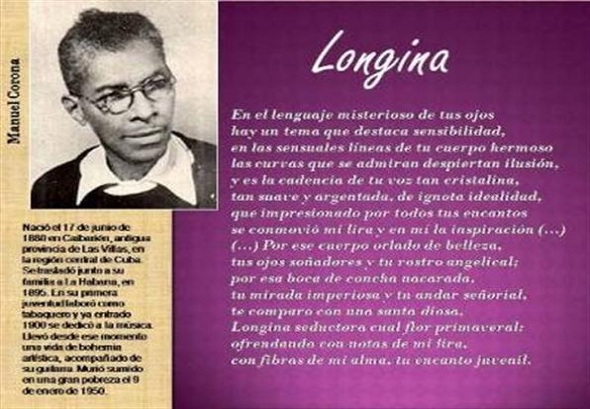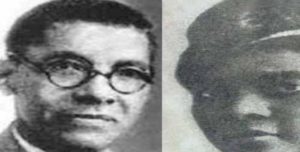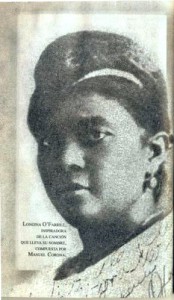 STORY OF A BOHEMIAN: THE GREAT MUSICIAN MANUEL CORONA.
STORY OF A BOHEMIAN: THE GREAT MUSICIAN MANUEL CORONA.
The famous composer and guitarist, Manuel Corona, of father mambí, was born in the so-called Villa Blanca de Caibarién, former province of Las Villas, on June 17, 1880 and died in Havana on January 9, 1950.
Corona was one of the four greats of the Cuban troubadour song, along with Sindo Garay from Santiago, the author of La tarde, Perla marina, Mujer bayamesa, among others, by Alberto Villalón with his anthology Boda negra or El Me da miedo Quererte. .. and the great Rosendo Ruiz with his False oath, Confession and Sad Omen.
Returning to the reason why we remember that his authorial work transcended in time, not only in Cuba but beyond the seas, the titles dedicated to women stand out, and this is the case of Longina, Santa Cecilia, Mercedes, Adriana, Aurora, Gela Amada who wrote it as an answer to beautiful Gela written by Rosendo Ruiz.
Longina was written in 1918 and the history of this song can be found in an interesting work by Professor Eduardo Vázquez Pérez.
Corona, like every bohemian man, always with his guitar on his shoulder and in his memory a wealth of poems turned into songs or songs made poems, was the troubadour par excellence of the serenades, the nights and the downloads of the bars of neighborhood in the first half of the last century.
From then on an unlimited number of songs written by the troubadour were born, among those already mentioned and others such as Longina, Santa Cecilia, La Alfonsa, Aurora, Double unconsciousness, Las flores del Edén, Adriana, Una mirada.
He also ventured into other musical genres such as the guarachas transcending, among others, the obligatory service, Accelera Ñico, Accelera, La Choricera, all inspired by that Cuban daily life of those times.
At the beginning of the twentieth century, year 1900, his bolero was born ” Double unconsciousness ”. When, two years later, his encounter in Santiago de Cuba with maestro José Pepe Sánchez, one of the first performers of the bolero and father of the Cuban troubadour song, shows him some of his works, and the renowned father of the Cuban bolero express; “You will be something remarkable, Corona, I tell you.”
Another peculiarity of Corona as a composer is that he wrote response works to songs made by other composers of his time, we already mention the case of Gela Amada, the same thing happens with Animada in response to Timidez, by Patricio Ballagas, La habanera, in response to The bayamesa of Sindo Garay, among many others.
Another of the great friendships of Corona was with another significant composer of the most genuine Cuban trova, Sindo Garay and his sons: Guarionex, Hatuey and Guarina, all of them integrated into the emblematic and transcendental movement of the old trova or traditional trova, which it reached its splendor at the beginning of the 20th century.
Corona was born and grows as a composer at a time when the Cuban composition was in full splendor, the times of Ernesto Lecuona, Jorge Anckermann, Gonzalo Roig, Luis Casas Romero, Eduardo Sánchez de Fuentes, Miguel Matamoros, Moisés Simons, Eliseo Grenet …
When we review the life and history of Corona, in addition to the anecdotes that tell the inspiration of some of its themes, we will find the musician, the composer, and also the creator, committed to the true essence of art and popular feeling.
 LA HISTORIA DE UN BOHEMIO: EL GRAN MANUEL CORONA.
LA HISTORIA DE UN BOHEMIO: EL GRAN MANUEL CORONA.
El afamado compositor y guitarrista, Manuel Corona, de padre mambí, nació en la denominada Villa Blanca de Caibarién antigua provincia de Las Villas, un 17 de junio de 1880 y murió en La Habana el 9 de enero de 1950.
Corona fue uno de los cuatro grandes de la canción trovadoresca cubana, junto a los santiagueros Sindo Garay, el autor de La tarde, Perla marina, Mujer bayamesa, entre otros, de Alberto Villalón con su antológica Boda negra o el Me da miedo quererte… y el gran Rosendo Ruiz con su Falso juramento, Confesión y Presagio triste.
Retomando el por qué del titulo recordemos que su obra autoral trascendió en el tiempo, no solo en Cuba sino allende los mares, se destacan los títulos dedicados a mujeres, y este es el caso de Longina, Santa Cecilia, Mercedes, Adriana, Aurora, Gela Amada que la escribiera como respuesta a Gela hermosa escrita por Rosendo Ruiz.
Longina fue escrita en el año 1918 y la historia de esta canción la pueden encontrar en en un trabajo interesante del Profesor Eduardo Vázquez Pérez.
Corona, como todo hombre bohemio, siempre con su guitarra al hombro y en su memoria un caudal de poemas convertidos en canción o de canciones hechas poemas, fue el trovador por excelencia de las serenatas, de las noches y de las descargas de los bares de barrio en la primera mitad del siglo pasado.
A partir de entonces nacieron un número ilimitado de canciones escritas por el trovador, entre las ya citadas y otras como Longina, Santa Cecilia, La Alfonsa, Aurora, Doble inconsciencia, Las flores del Edén, Adriana, Una mirada.
También incursionó dentro de otros géneros musicales como las guarachas trascendiendo entre otras, El servicio obligatorio, Acelera Ñico, Acelera, La Choricera, todas ellas inspiradas en esa cotidianidad del cubano de aquellos tiempos.
En el inicio del siglo XX, año 1900, nace su bolero ”Doble inconsciencia’. Cuando dos años más tarde se produce su encuentro en Santiago de Cuba con el maestro José Pepe Sánchez, uno de los cultores primeros del bolero y padre de la canción trovadoresca cubana, le muestra algunas de sus obras, y el reconocido padre del bolero cubano le expresa; “serás algo notable, Corona, yo te lo digo”.
Otra peculiaridad de Corona como compositor es que escribía obras de respuesta a canciones hechas por otros compositores de su tiempo, citamos ya el caso de Gela Amada, sucede lo mismo con Animada como respuesta a Timidez, de Patricio Ballagas, La habanera, como respuesta a La bayamesa de Sindo Garay, entre muchas más.
Otra de las grandes amistades de Corona fue con otro significativo compositor de la más genuina trova cubana, Sindo Garay y los hijos de éste: Guarionex, Hatuey y Guarina, todos ellos integrados al emblemático y trascendental movimiento de la vieja trova o trova tradicional, que alcanzó su esplendor en los comienzos del siglo XX.
Corona nace y crece como compositor en un momento en que la composición cubana estaba en pleno esplendor, los tiempos de Ernesto Lecuona, Jorge Anckermann, Gonzalo Roig, Luis Casas Romero, Eduardo Sánchez de Fuentes, Miguel Matamoros, Moisés Simons, Eliseo Grenet…
Cuando revisamos la vida e historia de Corona, además de las anécdotas que cuentan los motivos de inspiración de algunos de sus temas, encontraremos al músico, al compositor, y también al creador, comprometido con la verdadera esencia del arte y del sentir popular.
Agencies/ HabanaRad./ Raúl Fuillerat/ Internet Photos/YouTube/ Arnoldo Varona/ TheCubanHistory.com
THE CUBAN HISTORY, HOLLYWOOD.







